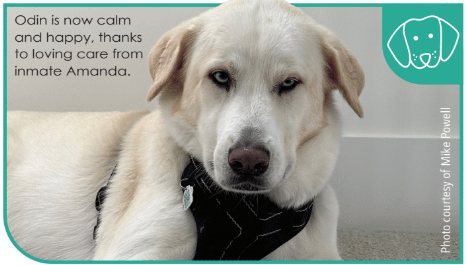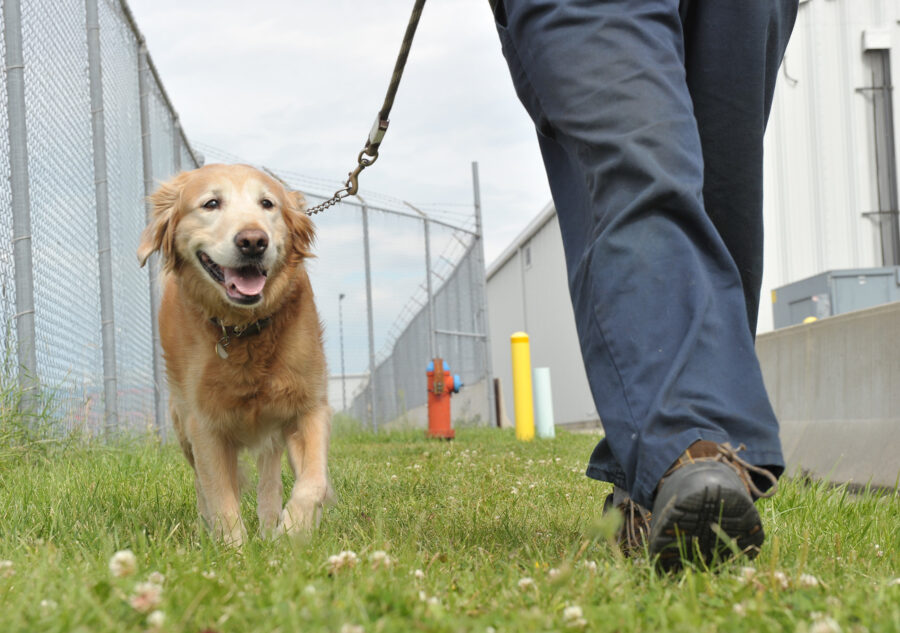Discover how prison dog programs help inmates transform their lives through the healing bond with dogs.
When it comes to the life-changing impact that dogs can have on humans, probably the most striking examples come from prison inmates. These hurt, hardened, embittered individuals frequently respond more positively to dogs than they do to their fellow humans. Thanks to a growing number of prison dog programs, more and more offenders are turning their lives around.
Insecure attachments can predispose people to criminal activity
According to attachment theory, babies form a secure attachment to their mothers. Mothers tune into their babies so they can fulfill their needs. Inconsistent care from the mother, however, leads to an insecure attachment.
These relationship styles become templates for subsequent bonds, says Colleen Dell, a professor at the University of Saskatoon who studies the human-animal bond. Children with secure attachments connect authentically with others. Those with insecure ties are more anxious to belong, and more likely to get involved in criminal activity.
Dogs offer non-judgmental support
This is where dogs come in. By offering non-judgmental comfort and support to prison inmates, a dog becomes a surrogate attachment figure.
The dog gives you attention that you didnt have to do anything for, Colleen says. That would be the definition of helpful parenting.
Once the dogs gain their trust, offenders tend to open up more to other humans. As testimony, lets take a look at two prison dog programs — The Doghouse and Marleys Mutts Pawsitive Change Prison Program. Both programs are howling successes.
The Doghouse Fraser Valley Institution, Abbottsford, BC
Odin is terrified by the unfamiliar noises in the prison his body is shaking and his tail is between his legs. Inmate Amanda can relate she too is scared of loud sounds. She takes the dog back to her cottage and cuddles with him until hes calm. They bond instantly.
When Im comforting Odin, says Amanda, hes also comforting me.
Amanda is one of roughly 250 inmates who have participated in The Doghouse, a vocational training program for offenders at the Fraser Valley Institution. The program provides grooming, boarding, and dog training services for the public, and also teaches basic obedience to rescue dogs from the Langley Animal Protection Society. The program also benefits inmates in a huge way.
Offenders not only learn techniques such as recognizing animal body language and practicing dog first aid, but also acquire skills such as communication, discipline and responsibility, according to Alicia Santella, manager of the program. These abilities can transfer into any job they pursue upon release.
Amanda never had the opportunity to gain soft skills. Now 38, she grew up neglected by her parents, who favored her siblings.
I just felt alone all the time, she says. Incarceration made her feel even lonelier, as she became estranged from her relatives. She grew deeply depressed and rarely left her room.
But the Doghouse prison dog program snapped her out of her doldrums. The woman who used to sleep in every day now rises at dawn to feed the dogs in the kennel. Her people skills have improved, and shes now able to handle difficult co-workers. Most importantly, the dogs have affirmed Amandas intrinsic worth.
They just love me, no matter what I do, she says.
Program participants self-worth rises alongside their accomplishments, adds Alicia. Most of The Doghouses clients are pleased with the superior care their dogs receive, and contact with supportive members of the public can help build [the inmates] confidence in themselves, Alicia says.
Amanda has blossomed since joining The Doghouse. Many clients have praised her work, telling her their dogs dont want to leave her care and come home. Amanda has also forged some close relationships amongst her fellow dog-lovers, some of whom she now considers her new family.
Im happier, she says. Im smiling all the time.

Marleys Mutts Pawsitive Change Prison Program North Kern State Prison, Delano, CA
Burly inmate Melvin struts across the yard at North Kern State Prison and encounters a rare situation a creature who defies him. Leila, his first dog in Marleys Mutts Pawsitive Change Prison Program, is an unruly poodle who barks at staff and tackles other animals. Melvin reins her in by teaching her to sit still on a mat during the dogs playtime. He earns Leilas obedience, and discovers how to mold an animal using connection rather than coercion.
This prison dog program, which pairs death row dogs in shelters with incarcerated inmates inside California state prisons, has brought redemption to over 1,000 humans and more than 500 dogs.
During the 14-week program, inmate students learn dog training techniques. The rehabilitation is bi-directional. The under-socialized dogs are mostly unadoptable and slated for euthanasia when they first enter the Pawsitive Change program, according to founder Zach Skow. But by the end, theyve become model canine citizens and most find forever homes.
Meanwhile, the inmates learn empathy as they recognize themselves in their abandoned and often abused charges. Empathy was in short supply during Melvins childhood. He was only five when his father was murdered.
That left me with a void, he says, and an unbearable pain that he suppressed. But the loss made him more vulnerable to peer pressure, and at age 11, he joined a gang that schooled him in drug-dealing and violence. If I had to make a statement, it wasnt by talking, says Melvin.
The Pawsitive Change program challenges these machismo attitudes. It teaches inmates how to access troubling emotions such as sadness or anger before they transmit them to the dogs, says Zach. When students are faced with unproductive feelings, theyre encouraged to process them by talking to a teammate or just taking a break.
Students also learn to tune in to the dogs experiences. If a dog becomes aggressive when touched, for example, inmates are invited to view this as a manifestation of fear rather than a personal insult, says dog trainer Nhut Vo. Students learn to accommodate these frightened animals, using a longer leash to give them more space. This flexible approach to relationships can also be applied to human interactions, Nhut advises.
As his successes mounted, Melvins self-esteem increased. Watching the dogs improve kindled hope in his own ability to change.
The work also fostered a sense of purpose. Even though he was still in prison, Melvin had found a way to give back, he says. It was fulfilling.
Collaboration is another outcome of the Pawsitive Change program. While the prison system is racially segregated, the participants have to cooperate to train the animals, says Nhut. Inmates frequently pool their money to buy treats for the dogs and celebrate their adoptions with brownies.
These lessons have generated impressive outcomes. Most graduates of this prison dog program find work in the pet industry after theyre released, says Zach. Not one has reoffended.
Today, Melvin is thriving. Since his release from prison eight months ago, hes reconnected with his family and procured work as a dog trainer. Im thankful just to be in the sun, watching dogs play, he says. Its beautiful.








